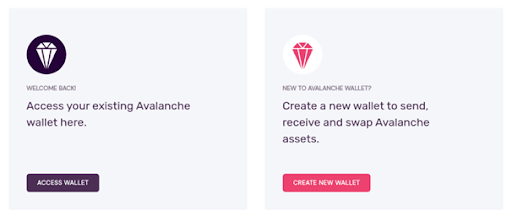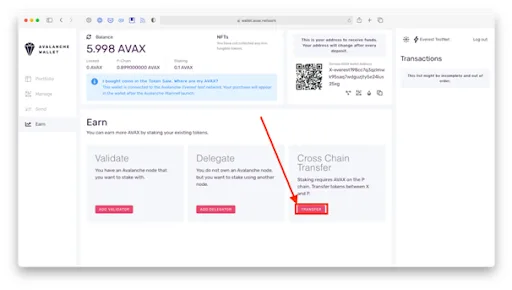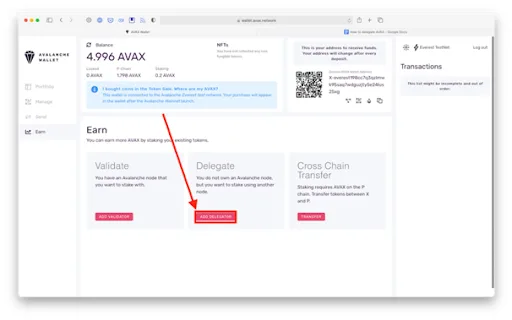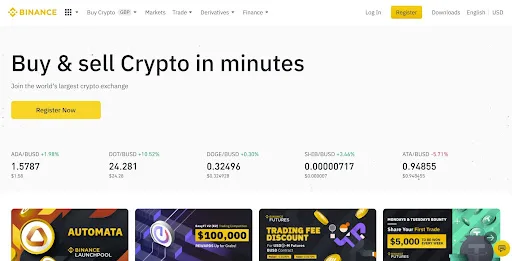Daily earnings
$0.00
0 AVAX
Weekly earnings
$0.00
0 AVAX
Monthly earnings
$0.00
0 AVAX
Yearly earnings
$0.00
0 AVAX
Avalanche is a blockchain that allows developers to launch multi-functional decentralised applications (dApps) and enterprise blockchain solutions. The network targets the limitations of similar development blockchains, like Ethereum, with its highly scalable, interoperable and efficient transaction ecosystem. Developers deploying their solutions on Avalanche can easily create secure, reliable and powerful applications.
Avalanche's native cryptocurrency is called AVAX. AVAX is used to pay fees, provide a unit of currency between different subnets of the Avalanche network and secure the Avalanche blockchain through staking.
In this guide, we will go through the different ways users can earn yield from their AVAX tokens.
Staking is the process of depositing and locking up cryptocurrency tokens to participate in a blockchain's Proof-of-Stake (PoS) consensus mechanism. Staked tokens are used to validate transactions and secure the associated network. There are several cryptocurrency blockchains that implement this mechanism, including Avalanche. Staking rewards are offered to incentivise users to lock up their coins.
Any person who wishes to support the Avalanche Proof-of-Stake mechanism can do so by locking a specified amount of the blockchain's native cryptocurrency AVAX. The staked cryptocurrencies cannot be moved or used during the locking period. The deposit of staked AVAX tokens ensures that validation nodes are committed to the development and stability of the network.
There are two ways users can stake AVAX tokens: become a validator or become a delegator.
Validators can be thought of as active nodes in the network that validate transactions and secure the blockchain. The more tokens that a validator has staked, the more frequently a validator will be asked to participate in the network, which means increased rewards.
Delegators are those who wish to stake but want to remain relatively passive. Delegators trust an existing validator node through the delegation of their staked tokens. Delegators are subsequently rewarded for their support.
To become a validator in the Avalanche network, a user must stake a minimum of 2,000 AVAX tokens. These tokens must be staked for a minimum of 2 weeks and a maximum of 1 year.
To ensure the decentralisation of the system, each validator holds a maximum weighting. The maximum weighting is composed of the validator's stake plus the stake delegated to them. The maximum weight is the minimum out of 3 million AVAX tokens or 5 times the amount staked by the validator. For example, if a user staked 2,000 AVAX to become a validator, they can only be delegated 8,000 AVAX. This safety mechanism is implemented to prevent validators from creating multiple rogue nodes that act like delegators. This would defraud the system through a Sybil attack.
To receive staking rewards, a validator must be online and correct at least 60% of the time. Alongside collecting rewards, validators can set their own delegation fee that they charge to delegators for their services.
To become a delegator in the Avalanche network, a user must stake at least 25 AVAX tokens. Like validators, these tokens must be staked for a minimum of 2 weeks and a maximum of 1 year.
When delegating staked tokens, a user must choose to allow a validator node to process transactions on their behalf. Choosing to delegate AVAX tokens does not put your AVAX at risk. A validator cannot spend staked AVAX tokens and a user will always receive the original staked amount plus staking rewards at the end of the locking period. Rewards collected by the validators are distributed back to delegators proportional to the number of staked tokens.
Note: Delegators are charged a delegation fee by validators due to the increased effort validators must employ. This delegation fee is usually not less than 2%.
Now that you know what Avalanche staking is, let's look at the specific ways a user can stake AVAX tokens.
Staking in the Avalanche network can be completed through a digital wallet or via an exchange.
The easiest way to earn AVAX is through an exchange or specialised lending platform. These services offer you yield on AVAX deposits in one of two ways; Via staking AVAX in a node on your behalf, or by lending it out. While the methods vary, the end result is the same – you earn yield which is paid out as additional AVAX. The added benefit of earning AVAX this way is that you don't need to run a full node, which requires 2000 AVAX coins.
Use the table below to compare rates on AVAX then forecast your earnings using the calculator provided.
$0.00
0 AVAX
$0.00
0 AVAX
$0.00
0 AVAX
$0.00
0 AVAX
| Go to site | |||||
|---|---|---|---|---|---|
| CEX.IO Cryptocurrency Exchange | 5% | 4% | Varies | Variable | |
| Okcoin | 6.92% | % | Variable | Earn now |
Here we will run through the steps to become a delegator using a wallet.

The Avalanche blockchain is made up of 3 sub-chains: The Exchange Chain (X-Chain), the Platform Chain (P-Chain) and the Contracts Chain (C-Chain).
X-Chain is the main asset chain on Avalanche used for the creation of new asset classes. An address created in this chain is known as an X address. When you hold your assets in your X address, they remain liquid, meaning that you are free to transfer them to other X addresses or P addresses.
P-Chain is the platform chain that manages metadata in the Avalanche network, such as staking. An address created on the P-Chain is known as a P address. When you hold assets in a P address, you make them illiquid. You will not always be able to move your assets into your X address freely, and you cannot transfer them to another P address. To move assets from one P address to another, you have to send them back to your X address and then send them to another P address.
C-Chain is the contracts chain that enables the smart contract functionality of decentralised applications. While the X- and P-Chains are involved in the staking process, the C-Chain is not.


On the next page, you will receive a list of validators ordered by the total amount staked. Choose one validator by clicking on the "SELECT" button.
You will be presented with the delegate page where you must choose your staking period, the amount you wish to delegate, and specify the address you want to receive your rewards. You cannot stake for a longer period than the validator node you choose.

The method for becoming a validator is similar to becoming a delegator but requires slightly more technical expertise. As a validator, you will be responsible for keeping the node online 24/7 and you will need to stake a minimum of 2,000 AVAX. By becoming a validating node in the network you will validate new blocks and mint new AVAX tokens. For more information on becoming a validator please view the Avalanche documentation here.
Instead of delegating or launching a validator node, an AVAX token holder can stake AVAX through a cryptocurrency exchange such as Binance. In this case, Binance acts as the validator and takes care of the technical aspects of staking in Avalanche. Staking rewards are calculated and paid out daily.
How to stake AVAX through an exchange like Binance
Step 1. Binance exchange. Head over to the Binance exchange.
Step 2. Create an account or log in. If you don't already have a Binance account, click "Register" and follow the account guidelines. If you already have a Binance account, log in to your account.
Step 3. Acquire or deposit AVAX tokens. If you do not already own AVAX tokens, purchase some via the exchange either via a fiat to crypto purchase or crypto to crypto exchange. If you already own AVAX tokens, transfer them to the exchange.
Step 4. Binance Earn. Once funds are held in your Binance wallet, click the "Finance" tab at the top of the screen, followed by "Binance Earn".
Step 5. Find AVAX products. In the search bar, type "AVAX" and find the earning products related to AVAX tokens.
Step 6. Staking. Find the staking product and click "Stake". Enter the amount of AVAX tokens you would like to stake and the time period you wish to lock your assets up for.
Step 7. Confirm. Accept the terms and conditions and confirm the transaction.
Once confirmed, you will begin accruing staking rewards within the Binance exchange.
According to the Avalanche website, at the time of writing (September 2021) the average AVAX staking yield is approximately 10% APY. The maximum yield is 11% APY. To earn the maximum amount, a user must be correct over 60% of the time and stake every day throughout the year.
Ultimately, how much a user can earn staking AVAX is dependent on a few factors:
In terms of real-world value, it will depend upon the market at the end of the locking period. If the price of AVAX increases during the locking period, the cumulative total of AVAX tokens, plus yield, will be worth more. However, if the price of AVAX decreases, the cumulative total may be worth less than at the start of the staking period.
Staking AVAX tokens through the Avalanche wallet is a relatively safe process as the wallet is an offline application, even though it runs inside a web browser. The wallet is a JavaScript app that leverages web technology for the front end which means it appears in the browser but does not connect to a server.
For extra safety, a user can double-check they are using the Avalanche network by unplugging or disconnecting the computer from the Internet. When a user enters their secret key or mnemonic phrase for wallet access, the process should still work.
So far, many investors have used the Avalanche wallet to stake AVAX without any major security complications.
Staking AVAX tokens through an exchange such as Binance adds an extra level of uncertainty to the process due to dealing with a third party. While Binance and other cryptocurrency exchanges are extremely secure, they are inherently at more risk due to being connected to the Internet.
Learn how to stake PIVX and earn rewards with this visual step-by-step guide.
Here are a few legitimate ways to earn free crypto. See which methods interest you, find out how to get started and grow your digital wallet.
Earn passive income through staking or lending your idle QTUM. Estimate your returns with our lending rates calculator.
Learn how to stake and earn yield on USDC holdings with cryptocurrency exchanges, lending services and DeFi applications.
Staking is the process of locking up KSM tokens in a wallet to earn rewards. Read on to find out how and where you can stake KSM tokens.
Learn how to stake and earn yield on BUSD holdings with cryptocurrency exchanges, lending services and DeFi applications.
In this guide, we will cover how to stake and lend NEO. Estimate your returns with our lending rates calculator.
Earn passive income through staking or lending your idle XTZ. Estimate your returns with our lending rates calculator.
Earn passive income through staking or lending your idle SNX. Estimate your returns with our lending rates calculator.
Staking is one of the most popular ways to earn an income with cryptocurrency – learn how to get started with this guide.